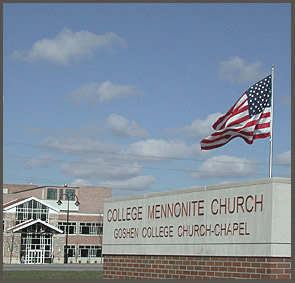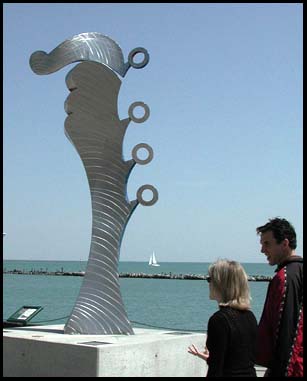| Ethics,
Plagiarism, and the Law
read me first
As a teacher it is important to model
good behavior and set an example for students to emulate. Therefore,
I attempt to be very diligent about giving credit whenever I make a quotation
or use an idea from somebody else. I can not tell you how many times
I have seen public speakers violate this common decency when showing cartoons,
and other slides without crediting the author, artist, or photographer.
For teachers in the classroom, quoting
and/or copying images and artwork should be treated with the same respect
that we expected of text.
Therefore
Any copied images or
artwork should always be credited with the name of the artist, photographer,
cartoonist, author, etc. along with bibliographical information about the
source of the copied work being shown. Not to do so in a classroom
presentation sets an example of plagiarism by the teacher.
In Powerpoint presentations
this information should be clearly visible, but for the sake of design,
I format it smaller than the major text points. For an image, I run this
along the bottom of the slide, just below the image and caption, or for
a vertical image it would be along side of the image under the caption.
Of course the artist's name might be part of the caption.
I assume that all artwork is copyrighted
- including my own. This is true whether or not there is any designation
with a symbol or word. The following is a link to an off site web
site that explains this for teachers.
Laws
about copyrighted artwork
in the classroom environment.
Since the above
link takes you to a site that is designed with frames, you will have to
scroll down the in the left frame until you can click the copyright
link.
To get back here, use your Back button (top left on your browser).
This site gives explanation of what is legally permitted in the classroom.
It is a site titled ArtLex.com, Copyright
© 1996-2002 Michael Delahunt. This site is also a good place
to find the correct spelling and pronunciation of artist names.
We are never allowed
to publish images on our own www web sites, even purely educational web
sites, without permission from the copyright owner. If you think
nobody will find them, think again. Search engines routinely find
pages soon after they are posted on the server - even if no link has been
made to the page.
We are never allowed
to use other's images for any business use, trade use, advertising,
advocacy work, etc. without permission.
The Ethics of
Student Copy Work
Should art students
be allowed to copy the images of other artists and photographers as part
of their assignments or class work?
I do not encourage
copy work on the grounds that is is not a good way to become a creative
contributing artist. If students do copy or "quote" artwork or photographs
that are not their own, I would say it is plagiarism unless it has bibliographical
credits (clearly apparent footnotes). Similar to the standards used
for term papers and other written work. As art teachers, we need
to be clear and help students understand this. Many people
do not realize that honesty in the visual world is at least as important
as honesty in the verbal and accounting worlds.

title:
Signs
of the Times
photo
by Marvin Bartel © 2002
This
photograph illustrates the idiosyncratic symbolism seen in much of the
post-modern world. A flag is placed in the front parking lot of a
Cancer Center Hospital seen in the background of this photograph.
The flag is seen here in the middleground of the photo, but because it
is unusually large and because of the photographer's camera position, it
appears to be placed on a church sign. The camera angle places a
Mennonite Church's sign in the foreground directly under the flag which
is actually across the street. This is a "straight" photograph.
No digital cutting and pasting were used to create the mergers. No changes
were made in the scale of the objects other than using a slightly wide-angle
zoom of the camera lens..
A photography
teacher may wish to copy and show this image in class to illustrate the
use of mergers to make a photographic statement. As the photographer,
I give you permission to use this for classroom presentations. This
photograph may be used to practice "taking a photograph" from the Internet.
© Marvin Bartel, posted 2002
All rights reserved. Teachers may make one
copy of this webpage for their own personal reference so long as this
URL (web page address) and this copyright notice is included. You may
make a link to this page from your website, but you may not place a
copy on your website.
Updated 6/2008
Send your comments or permission requests CONTACT
Other essays on Art Education Home page by the same author
How to Use a Digital Camera to Copy Slides
How to Hang
Artwork Temporarily with Masking Tape
|
|
Taking an
IMAGE FROM THE WEB to use in teaching.

title:
Wave
Dancer
artist:
John
Mishler - 2002 ©
stainless
steel and paint
14'
x 3' x 4'
photo
by Marvin Bartel © 2002
This photograph
shows two college students at Navy
Pier in Chicago discussing sensations evoked by a Mishler site specific
work in context. The top portion turns in the breeze adding kenetics to
the work. Misher teaches sculpture at Goshen College.
A sculpture
teacher may wish to copy and show this image in class to illustrate the
use of design in context. As the photographer, I give you permission
to use this for classroom use. This photograph may be used to practice
"taking a photograph" from the Internet.
How
to find an art history image.
Google
Images Search is a great place to start. In the search box you
can type the artist's name and/or the name of the artwork. Sometimes
it will even suggest a better way to spell the name. However, knowing
the correct spelling is best. For well known art, it is apt to find
many choices. For Vincent Van Gogh's painting, Starry Night,
there appear to be over 100 choices with a large variety of quality.
In general, larger file sizes are better quality but slower to load when
browsing with a modem connection.
Art history texts, other art books, encylopeidias,
dictionarys, etc. are good sources for appropriate names and artwork ideas.
If a book has a high quality reproduction, a flatbed scanner could be used
to attain an image (within the limits of fair
use - Since this link takes you to a site
that is designed with frames, you will have to scroll down the in the left
frame until you can click the copyright
link).
How
to "take a picture" from the web.
-
In order to print an image to show in a classroom,
you can place the cursor on the image and use the right mouse button, hold
it down, pick "save image" or "save picture" (with a single button Mac
mouse, hold down the mouse until the dialog box appears).
-
Designate and watch
where you save it on your computer drive. Images on the web
are generally .jpg image format that is easy to open with Photoshop and
can be INSERTED and/or opened with many other programs.
-
Open a new file in Word (some other word processors
also work) and use the top menu to find INSERT, PICTURE, FROM FILE, and
place the image on the page. Then size it by clicking on it and
grabbing a corner.
You can also slide it where you like it.
This can also be done using Powerpoint
instead of Word. Powerpoint is better for presentation programming
if the classroom is equipped for projection from a computer. Word
is better for printing for overhead transparencies or handouts.
Sometimes I first size it and work on the
image in Photoshop. Of course you can print from Photoshop, but it seems
easier to add the caption and source credits if you insert them into a
word processor or Powerpoint.
-
In another Word file I collect bibliographical
text information from the web site. In this Word file I can fix the
formatting. Then I can copy and paste it into the presentation slide
or overhead layout file.
-
From the top menu, use INSERT and TEXT BOX
(in Powerpoint). Then use Copy and Paste to include sources such
as the web site address and the owner/publisher/author bibliographical
credits for the source of the image, and for the title, artist, dates,
and so on. It is hard to say exactly what is legal and within copyright
laws, (see copyright notes and links on left here) but teachers are allowed
a bit of "fair use" leeway that commercial users are not permitted. We
should at least give credit if we take these images from web pages (we
are NOT permitted to publish them on our own Internet web pages without
permission).
-
If you do not have image software such as
Adobe Photoshop, printing can be done from Microsoft Word . Teachers
without computer projectors may wish to print art images as transparencies
for overhead projectors to show to a class. Blank transparencies
(from office suppliers) are available for inkjet and for laser printers,
but be sure to use the correct ones, paying attention to the type of printer.
CAUTION: Laser printers are hot and
melt the plastic media for inkjets. You could damage the printer,
if the wrong transparency media is used.
Protected web sites.
Presumably,
some art galleries and museums are using software in an attempt to
protect
themselves from unauthorized use. I open the page in Netscape, go
to File, Edit Page. When the image comes up, I copy and paste
it.
If your web browser does not allow page editing, try searching "screen
capture" and/or "print screen" to find a instructions for other ways to
copy and paste.
Other
links related to the above
INSTRUCTIONS FOR PHOTOSHOP
(as of 2002)
Basic
Image File Preparation Using Adobe Photoshop 5
Using
Layers to produce a Montage Composite using Photoshop 6 2002
How
to Print Photographs from a Mac
https://www.goshen.edu/art/ed/Printing.html
Try a web search if these links are outdated.
|